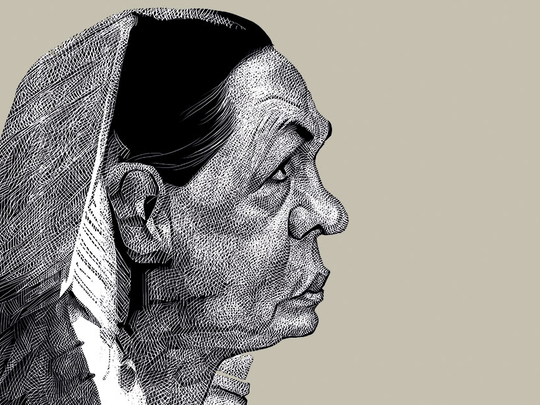
Quite like her illustrious mother-in-law, Sonia Antonia Edvige Albina Maino has a penchant for cotton saris. And on her wedding day, marked by a simple ceremony in New Delhi in 1968, Sonia wore the same sari that her mother-in-law had worn on her wedding. That pink sari was former Indian prime minister Indira Gandhi’s wedding gift to her daughter-in-law.
Soon thereafter, the newly-wed Italian wife of Rajiv Gandhi, Indira’s elder son, developed a special bonding with Indira — a tie that brought the two women emotionally close to one another.
The Sunday afternoon trips with Rajiv to India Gate — spending quality time over a humble ice-cream; accompanying Indira to many of her social commitments around Delhi; or simply being a spectator at the capital’s National Gallery of Modern Art were part and parcel of Sonia’s acclimatisation to life and times in India, as much as her initiation into managing the nitty-gritties of the Gandhi household.
From being the ‘firangi’ (foreigner) ‘bahu’ (daughter-in-law) of India’s ‘first family’ to emerging the Congress party’s longest-serving president (1998-2017), Sonia Gandhi’s life is one riddle that continues to enthral myriads of political commentators and analysts. From her courtship days with Rajiv in 1965, to handing over the mantle of the oldest and largest political party in India to son Rahul last Sunday, Sonia’s tryst with India constitutes a remarkable narrative whose every chapter leads you on to the next with an even bigger promise of intrigue and awe than the preceding one.
On that fateful morning of October 31, 1984, when Indira was gunned down by her own bodyguards at her Safdarjung Road residence, Sonia was left holding fort, until Rajiv, then the Congress party general secretary, rushed back from his trip to West Bengal. Late into the night, as senior Congressman Pranab Mukherjee went to the Gandhi household to convince Rajiv to take charge of the country’s most important public office at such a critical juncture, a distraught Sonia desperately clung on to a shaken Rajiv — pleading him against such a move. Thirty-three years later, last Sunday afternoon, barely a few 100 metres away from that same Safdarjung Road house, a contented Sonia looked on as the fifth-generation Nehru-Gandhi scion, Rahul, delivered his acceptance speech as Congress president.
Life indeed has come full circle for Sonia.
In these 33 years, Sonia’s resolve as a politician and her commitment to her party’s cause have seen her emerge as a truly evolved public persona, but with a mystique’s zeal to keep her private life beyond the purview of prying eyes. Even in this age of 24/7 news and an ever-expanding social media footprint, it is truly remarkable how Sonia has so very successfully maintained her public and private selves as two watertight compartments — one complementing the other, without compromising on their intrinsic worth. Right from the time when she was dating Rajiv to until her last day as Congress president, Sonia has maintained an extremely dignified distance from the lure of any over-the-top publicity in a country where discretion hasn’t always been the better part of valour with a large number of public figures and celebrities. She has earned every bit of that respect that the media in India and abroad has accorded her in all these years. A clear case in point being the way her visit to the United States in the summer of 2011, for an emergency surgery, was covered in print and electronic media — sans the compulsive intrusiveness of ‘breaking news’, that is.
What a journey!
Born to working-class parents Stefano and Paolo on December 9, 1947, in a village called Orbassano, near Turin, Sonia’s early life bore the stamp of middle-class values, accentuated by an aspiration quotient that propelled her parents to send their daughter to Cambridge for higher studies. But little did Sonia or her parents know that this short journey from Turin to London would soon morph into a gigantic leap for that seemingly ordinary girl. Sonia’s Cambridge stint and her relationship with Rajiv changed the contours of her life forever — catapulting her from the chapters of everyday storytelling to the annals of India’s political history.
And what a journey it has been.
From consoling her husband after Indira’s ghastly assassination in 1984, to standing rock-steady by her two teenaged children, Rahul and Priyanka, near the funeral pyre as flames engulfed the mortal remains of Rajiv, blown to smithereens by a human bomb in 1991, to rejecting the offer for prime ministership after the 2004 election victory, to anointing Rahul as party chief in 2017 — it’s almost like life imitating art.
After Rajiv’s gruesome death, Sonia stayed away from politics for seven years. Working as an art restorer and editing a series of personal letters exchanged between Indira and her father, India’s first prime minister Jawaharlal Nehru, kept her busy. But the dwindling fortunes of the party at the hustings finally convinced her to bite the bullet. When she took over as party president in 1998, Congress was just a shadow of its heydays. But her relentless efforts not only saw Congress post a stunning win in the 2004 general elections, but it was primarily Sonia’s guile and political acumen that enabled her party to lead two successive coalition governments at the Centre.
“Power in itself has never attracted me, nor has position been my goal.” With that one comment and the masterstroke of nominating a soft-spoken technocrat like Manmohan Singh for prime minister, Sonia silenced the opposition’s war cry over her foreign origin for good. From mastering spoken Hindi to taking Indian cuisine to heart, Sonia’s attachment with the country is phenomenal.
The enduring enigma about her has been the Congress’ biggest political capital over the last two decades, which now offers Rahul plenty of elbow room to hedge his bet.
You can follow Sanjib Kumar Das on Twitter @moumiayush









